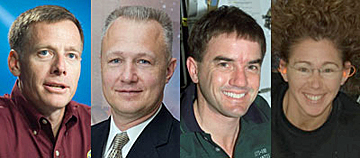Final shuttle crew named for possible station flight

in orbit aboard Endeavour in 2008. Ferguson
will command the shuttle program's
final crew. (Photo: NASA)
But it is not yet clear when differences between the House and Senate versions of NASA's fiscal year 2011 budget will be resolved or when a decision will be made about whether or not to launch Atlantis on an actual mission. In the meantime, Ferguson, Hurley, Walheim and Magnus will begin generic training to keep the agency's options open.
"These astronauts will begin training immediately as a rescue crew as well as in the baseline requirements that would be needed to fly an additional shuttle flight," Bill Gerstenmaier, director of space operations at NASA headquarters, said in a news release. "The normal training template for a shuttle crew is about one year prior to launch, so we need to begin training now in order to maintain the flexibility of flying a rescue mission if needed, or alter course and fly an additional shuttle mission if that decision is made."
Ferguson is a veteran of two shuttle missions to the space station, serving as pilot of mission STS-115 aboard Atlantis in September 2006 and commander of Endeavour for mission STS-126 in November 2008. Walheim flew aboard Atlantis twice, in 2002 and 2008, while Hurley is a veteran of a single mission aboard Endeavour in 2009.
Magnus flew aboard Atlantis in 2002 and spent four-and-a-half months aboard the International Space Station in 2008 and 2009.
In the wake of the 2003 Columbia disaster, the Bush administration decided to finish the space station and retire the shuttle by the end of fiscal 2010. Congress subsequently promised an additional $600 million to ease concerns about schedule pressure, allowing NASA to revise and stretch out the manifest to cope with payload issues and conflicts with other missions.
As it now stands, the shuttle Discovery will blast off Nov. 1 to deliver supplies and a cargo storage module to the International Space Station. Endeavour will follow Feb. 26 to deliver a $2 billion particle physics experiment and additional high-priority supplies and spare parts.
All post-Columbia shuttle flights are orchestrated so that a second shuttle is available in case of a problem that might strand a crew in orbit. For Discovery's mission, Endeavour and its flight-deck crew are on call for rescue duty. For Endeavour, Atlantis is the designated launch-on-need vehicle.
But agency managers have been lobbying for months to convert Atlantis' mission into an actual space station resupply mission to take advantage of an external tank and boosters that otherwise would go to waste. The rescue mission -- or the actual flight, if approved -- would take off June 28.
By launching Atlantis with a crew of four, another standby rescue mission, including another set of solid-fuel boosters and an external tank, would not be needed. If a major problem stranded Ferguson and his crewmates in orbit, they could seek safe haven aboard the station and rotate back to Earth aboard Russian Soyuz spacecraft.

Hurley, Walheim and Magnus. (Photo: NASA/Spaceflight Now)
The external tank and solid-fuel booster segments needed for the launch-on-need mission are already built, but keeping the shuttle processing and flight control teams intact for an additional few months would require several hundred million dollars.
The Senate version of NASA's fiscal 2011 budget includes funding for the additional mission, known as STS-135, while the House version includes "contingent authorization" that would allow the agency to redirect space station and exploration funds to cover the cost if NASA Administrator Charles Bolden determines the flight is necessary and safe to carry out.
But is not clear how the reconciliation process will play out, when a compromise might be reached or whether NASA would proceed with the flight if the agency had to pay for it without additional money.